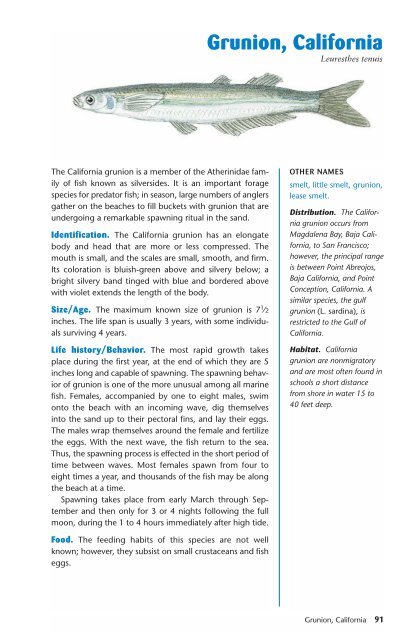Ken Schultz's Field Guide to Saltwater Fish - Macaw Pets store
Ken Schultz's Field Guide to Saltwater Fish - Macaw Pets store
Ken Schultz's Field Guide to Saltwater Fish - Macaw Pets store
Create successful ePaper yourself
Turn your PDF publications into a flip-book with our unique Google optimized e-Paper software.
The California grunion is a member of the Atherinidae family<br />
of fish known as silversides. It is an important forage<br />
species for preda<strong>to</strong>r fish; in season, large numbers of anglers<br />
gather on the beaches <strong>to</strong> fill buckets with grunion that are<br />
undergoing a remarkable spawning ritual in the sand.<br />
Identification. The California grunion has an elongate<br />
body and head that are more or less compressed. The<br />
mouth is small, and the scales are small, smooth, and firm.<br />
Its coloration is bluish-green above and silvery below; a<br />
bright silvery band tinged with blue and bordered above<br />
with violet extends the length of the body.<br />
Size/Age. The maximum known size of grunion is 7 1 ⁄2<br />
inches. The life span is usually 3 years, with some individuals<br />
surviving 4 years.<br />
Life his<strong>to</strong>ry/Behavior. The most rapid growth takes<br />
place during the first year, at the end of which they are 5<br />
inches long and capable of spawning. The spawning behavior<br />
of grunion is one of the more unusual among all marine<br />
fish. Females, accompanied by one <strong>to</strong> eight males, swim<br />
on<strong>to</strong> the beach with an incoming wave, dig themselves<br />
in<strong>to</strong> the sand up <strong>to</strong> their pec<strong>to</strong>ral fins, and lay their eggs.<br />
The males wrap themselves around the female and fertilize<br />
the eggs. With the next wave, the fish return <strong>to</strong> the sea.<br />
Thus, the spawning process is effected in the short period of<br />
time between waves. Most females spawn from four <strong>to</strong><br />
eight times a year, and thousands of the fish may be along<br />
the beach at a time.<br />
Spawning takes place from early March through September<br />
and then only for 3 or 4 nights following the full<br />
moon, during the 1 <strong>to</strong> 4 hours immediately after high tide.<br />
Food. The feeding habits of this species are not well<br />
known; however, they subsist on small crustaceans and fish<br />
eggs.<br />
Grunion, California<br />
Leuresthes tenuis<br />
OTHER NAMES<br />
smelt, little smelt, grunion,<br />
lease smelt.<br />
Distribution. The California<br />
grunion occurs from<br />
Magdalena Bay, Baja California,<br />
<strong>to</strong> San Francisco;<br />
however, the principal range<br />
is between Point Abreojos,<br />
Baja California, and Point<br />
Conception, California. A<br />
similar species, the gulf<br />
grunion (L. sardina), is<br />
restricted <strong>to</strong> the Gulf of<br />
California.<br />
Habitat. California<br />
grunion are nonmigra<strong>to</strong>ry<br />
and are most often found in<br />
schools a short distance<br />
from shore in water 15 <strong>to</strong><br />
40 feet deep.<br />
Grunion, California 91


